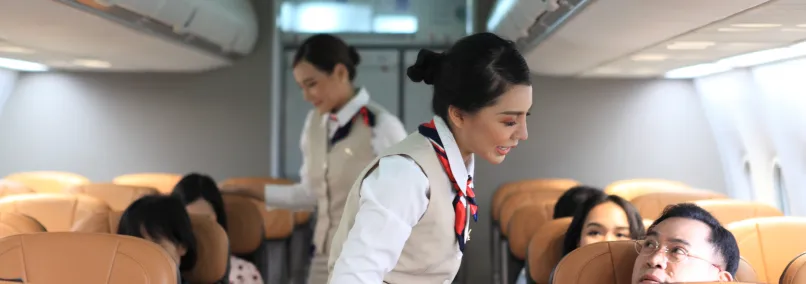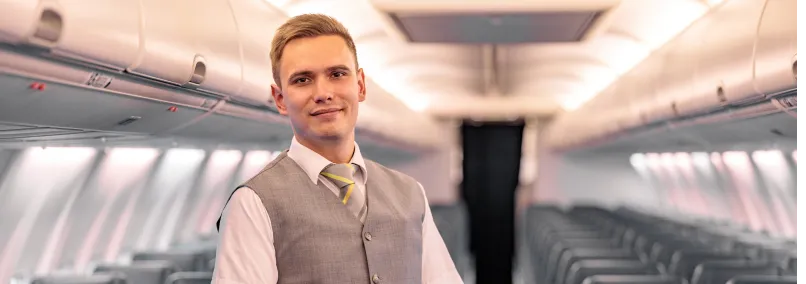A Guide to the Modern Flight Attendant Dress Code

Step onto any flight, and one of the first things you’ll notice—before the safety demonstration, before the beverage cart—is the uniformed crew ready to welcome you aboard. That polished, put-together look isn’t just a fashion choice; it’s a critical part of an airline’s professional image. A clearly defined flight attendant dress code ensures that every member of the cabin crew projects confidence, competence and consistency from gate to landing.
For airlines, uniform standards help build passenger trust, maintain brand identity and ensure crew readiness for every scenario, whether routine or unexpected. Let’s unpack the essentials of professional airline uniform standards, from grooming requirements and attire guidelines to tips for choosing uniforms that balance comfort, durability and style. Whether you’re refreshing your airline’s look or drafting policies for the first time, you’ll find best practices here to keep your crew looking sharp and your brand soaring.
Learn More:
Why a Dress Code for Flight Attendants Matters
The best flight attendant uniform is a visual handshake between an airline and its passengers. It communicates professionalism before a single word is spoken and sets the tone for the entire travel experience. In an industry where trust and perception are everything, the right dress code policy is as essential as on-time departures and smooth landings.
Brand Representation
Uniformed crews serve as walking brand ambassadors. A cohesive, polished appearance reinforces the airline’s identity, whether that’s sleek and modern or classic and refined. Every button, hem and accessory works together to tell a visual story that passengers instantly recognize.
Passenger Confidence
Passengers tend to equate a sharp, well-groomed crew with a capable, reliable airline. That visual consistency sends an unspoken message: “We’ve got this.” In a space where safety is paramount, even small visual cues can have a big impact on passenger comfort and trust.
Crew Cohesion & Morale
When everyone looks like part of the same team, they start to feel like part of the same team. A shared dress code fosters unity among the crew, boosting morale and professionalism. Plus, it spares employees the daily guesswork of “What do I wear?”, which frees them up to focus on delivering exceptional service.
Core Flight Attendant Appearance Requirements
Even the most stylish airline uniform loses its impact if it’s not worn and maintained according to clear standards. Flight attendant appearance requirements ensure every crew member looks polished, professional and ready for anything, from greeting VIP passengers to handling in-flight emergencies. These guidelines create consistency, promote safety and reinforce the airline’s image as organized and dependable.
Overall Grooming Standards
A professional look starts with neat, well-groomed hair that stays in place during a long shift. Makeup, if worn, should be subtle and enhance rather than overpower one’s look. Nails should be trimmed, clean and—if polished—kept in neutral, airline-approved shades to maintain a cohesive crew appearance.
Accessories
Accessories add personality, but in-flight safety and brand unity come first. Most airlines limit jewelry to small, non-dangling pieces and approve only brand-specific scarves, ties or pins. These help identify the crew and tie the uniform’s look back to the airline’s color scheme and logo.
Personal Hygiene
Uniforms should be clean, pressed and free from visible wear, ensuring flight attendants always look ready for takeoff. Light, fresh scents (or no fragrance at all) are preferred to accommodate passenger sensitivities. In a close-quarters cabin, impeccable hygiene is as important as the uniform itself.

Attire Guidelines for Airline Flight Attendant Uniforms
The visual impact of a cabin crew begins with the clothing itself. Airline flight attendant uniforms need to strike a careful balance between style, comfort and functionality, ensuring crew members can look professional while handling the demands of the job. From garment types to fabric selection, every detail contributes to a consistent, brand-forward image.
Garment Types
Typical uniform pieces include jackets or blazers, blouses or shirts, skirts or trousers and occasionally dresses for a more streamlined look. Each garment should align with the airline’s visual identity, using consistent colors and trims so the overall effect is cohesive. Optional items, such as cardigans or vests, can add versatility without compromising the brand image.
Fit & Function
A uniform may look stunning on the runway, but if it restricts movement or becomes uncomfortable after a few hours, it’s not doing its job. Flight attendants need well-tailored pieces that allow them to reach overhead bins, bend and walk the cabin with ease. Stretch fabrics, adjustable waistbands and strategic venting can make a world of difference during long shifts.
Fabric Choice
Airline uniforms benefit from fabrics that are wrinkle-resistant, breathable and able to stand up to frequent cleaning. Stain-repellent finishes can help maintain a neat appearance throughout a flight, while durable weaves prevent premature wear. A smart choice in fabric means the uniform keeps looking fresh, even after countless takeoffs and landings.
Seasonal Variations
Airlines that operate across multiple climates often provide warm-weather and cool-weather uniform options. Lightweight, moisture-wicking fabrics keep crew members comfortable in tropical destinations, while heavier, layered ensembles offer warmth for colder routes. Maintaining the same design elements across all seasonal versions ensures a consistent brand presence year-round.
Pro tip: Managing all these variables—styles, sizes, climates—can be a logistical challenge. That’s where a dedicated program manager can help keep your airline’s uniform program running smoothly, from ordering to delivery.
Selecting the Best Flight Attendant Uniforms
Choosing the best flight attendant uniforms means finding the sweet spot where comfort, durability and brand identity meet. Uniforms should make crew members feel confident and capable while holding up to the rigors of daily wear in a high-contact, fast-paced environment. The right choices look sharp and deliver long-term value for the airline.
Balancing Comfort & Style
A well-designed uniform gives crew members freedom of movement without sacrificing a polished look. Features like stretch panels, adjustable closures and lightweight linings ensure flight attendants stay comfortable on both short-haul hops and long-haul overnights. A uniform that feels good to wear is one your team will wear with pride.
Durability & Maintenance
Airline uniforms face constant wear and frequent laundering, so they need fabrics that resist fading, pilling and stretching out of shape. Easy-care, machine-washable materials reduce maintenance costs and keep crew members looking fresh with minimal effort. Investing in higher-quality construction pays off in both longevity and appearance.
Brand Identity
Uniforms are a moving billboard for your airline, making brand alignment essential. Whether it’s a signature color, a custom pattern or discreet logo embroidery, every design choice should reinforce your airline’s identity. Lands’ End Outfitters offers customization services with hundreds of thread colors and expert embroidery, ensuring your brand looks its best at 30,000 feet.
Implementing & Maintaining a Flight Attendant Dress Code Policy
Even the sharpest uniforms won’t make an impact if there’s no plan for rolling them out and keeping standards consistent. A strong flight attendant dress code policy sets expectations and builds a system to ensure they’re met, day after day, flight after flight. Clear guidelines, proper training and ongoing oversight keep crews looking polished and on-brand.
Written Guidelines
Put uniform and grooming standards in writing so they’re easy to reference and apply consistently. Detailed guidelines should cover everything from acceptable uniform combinations to approved grooming practices, ensuring there’s no ambiguity for crew members or managers.
Training & Orientation
Introduce uniform standards during onboarding so new hires understand expectations from day one. Providing fittings, style demonstrations and even “how-to” grooming tips sets a professional tone while giving crew members the confidence to meet the dress code every shift.
Ongoing Compliance
Dress code policies aren’t a “set it and forget it” effort. Periodic check-ins and refresher sessions help keep everyone aligned, especially if seasonal uniform updates or branding changes occur. Having a centralized ordering and distribution system makes it easier to maintain consistency across the entire crew.
Outfit Your Crew With the Best Flight Attendant Uniforms From Lands’ End
A well-crafted flight attendant dress code builds trust, boosts your brand and supports operational excellence. But the best policy is only as good as the uniforms that bring it to life. With decades of experience outfitting teams across industries, Lands’ End Outfitters knows how to design and deliver uniforms your crew will be proud to wear. With no-minimum embroidery orders and a vast selection of wrinkle-resistant, easy-care fabrics, every detail is crafted to support your brand identity and your crew’s comfort. Our customization options, including hundreds of thread colors and precision embroidery, ensure your airline’s image stays consistent at every altitude.
Shop Custom Company UniformsFrequently Asked Questions
Even with a strong uniform policy in place, questions can pop up. Here’s a quick reference for some of the most common inquiries airlines face when implementing or updating a flight attendant dress code.
What is the purpose of a flight attendant dress code?
A flight attendant dress code sets consistent appearance and grooming standards, ensuring all crew members represent the airline professionally. It reinforces brand identity, instills passenger confidence and supports operational readiness.
How often should uniforms be replaced?
Replacement timelines vary based on wear, laundering frequency and fabric quality. Many airlines refresh uniforms every 12-24 months, though high-quality, durable fabrics can extend that lifespan while maintaining a polished look.
Are there specific grooming rules for flight attendants?
Yes. Most policies cover neat hair, minimal professional makeup, well-groomed nails and limited jewelry. These guidelines ensure a cohesive, safety-conscious appearance across the crew.
What fabrics work best for airline uniforms?
Breathable, wrinkle-resistant and stain-repellent fabrics are ideal. They help crew members maintain a fresh, professional look throughout the flight while standing up to frequent laundering.
Can uniforms be customized for branding?
Absolutely. Customization, such as embroidered logos, signature colors or branded accessories, strengthens brand recognition. Services like Lands' End Outfitters' customization program make it simple to achieve a consistent look across your team.